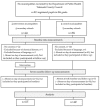Changes in Physical Activity, Physical Fitness and Well-Being Following a School-Based Health Promotion Program in a Norwegian Region with a Poor Public Health Profile: A Non-Randomized Controlled Study in Early Adolescents
- PMID: 32023995
- PMCID: PMC7037455
- DOI: 10.3390/ijerph17030896
Changes in Physical Activity, Physical Fitness and Well-Being Following a School-Based Health Promotion Program in a Norwegian Region with a Poor Public Health Profile: A Non-Randomized Controlled Study in Early Adolescents
Abstract
The purpose of this study was to examine the changes in physical activity (PA), physical fitness and psychosocial well-being in early adolescents following implementation of a school-based health promotion program in secondary schools.
Methods: Six municipalities in Telemark County, Norway, were recruited into intervention (6 schools) or control groups (9 schools). A total of 644 pupils participated in the study (response rate: 79%). The schools in the intervention group implemented the Active and Healthy Kids program, where the PA component consisted of (1) 120 min/week of physically active learning (PAL) and (2) 25 min/week of physical active breaks. Furthermore, both the intervention and control schools carried out 135 min/week of physical education. The primary outcome was PA. Secondary outcomes were sedentary time, physical fitness, subjective vitality and health-related quality of life (HRQoL) in five domains: physical health, psychological well-being, parent, peers and school.
Results: There was a group x time effect on school-based PA (p < 0.05), but not total PA, as well as on physical fitness (p < 0.05) and vitality (p < 0.01). In girls, there also was a group x time effect on three out of the five domains on HRQoL (p < 0.05).
Conclusions: A multi-component, school-based health-promotion program with emphasis on the use of PAL led to positive changes in school-based PA levels. Furthermore, positive changes were seen in physical fitness, vitality and HRQoL among early adolescents in a county with a poor public health profile. This might have implications for the development and promotion in schools of general health and well-being throughout adolescence.
Keywords: adolescents; intervention; physically active academic lessons; school-based physical activity; well-being.
Conflict of interest statement
The authors declare no conflict of interest.
Similar articles
-
A school-based physical activity program to improve health and fitness in children aged 6-13 years ("Kinder-Sportstudie KISS"): study design of a randomized controlled trial [ISRCTN15360785].BMC Public Health. 2006 Jun 6;6:147. doi: 10.1186/1471-2458-6-147. BMC Public Health. 2006. PMID: 16756652 Free PMC article.
-
Effectiveness of a multicomponent intervention to promote physical activity during the school day: rationale and methods of the MOVESCHOOL study.Front Public Health. 2025 Mar 12;13:1565914. doi: 10.3389/fpubh.2025.1565914. eCollection 2025. Front Public Health. 2025. PMID: 40144996 Free PMC article. Clinical Trial.
-
The effect of a school-based intervention on physical activity, cardiorespiratory fitness and muscle strength: the School in Motion cluster randomized trial.Int J Behav Nutr Phys Act. 2020 Nov 26;17(1):154. doi: 10.1186/s12966-020-01060-0. Int J Behav Nutr Phys Act. 2020. PMID: 33243246 Free PMC article. Clinical Trial.
-
Effect of school-based interventions on physical activity and fitness in children and adolescents: a review of reviews and systematic update.Br J Sports Med. 2011 Sep;45(11):923-30. doi: 10.1136/bjsports-2011-090186. Br J Sports Med. 2011. PMID: 21836176 Free PMC article. Review.
-
Monitoring of physical activity promotion in children and adolescents in the EU: current status and future perspectives.Eur J Public Health. 2022 Feb 1;32(1):95-104. doi: 10.1093/eurpub/ckab193. Eur J Public Health. 2022. PMID: 34791137 Free PMC article. Review.
Cited by
-
Physical education and student well-being: Promoting health and fitness in schools.PLoS One. 2024 Jan 25;19(1):e0296817. doi: 10.1371/journal.pone.0296817. eCollection 2024. PLoS One. 2024. PMID: 38271399 Free PMC article.
-
Gamified Health Promotion in Schools: The Integration of Neuropsychological Aspects and CBT-A Systematic Review.Medicina (Kaunas). 2024 Dec 19;60(12):2085. doi: 10.3390/medicina60122085. Medicina (Kaunas). 2024. PMID: 39768964 Free PMC article.
-
Effects of the inclusion of physical activity in secondary education academic classes on educational indicators and health markers: rationale and methods of the ACTIVE CLASS study.Front Public Health. 2024 Jan 5;11:1329245. doi: 10.3389/fpubh.2023.1329245. eCollection 2023. Front Public Health. 2024. PMID: 38249387 Free PMC article. Clinical Trial.
-
Multilevel modeling of technology use, student engagement, and fitness outcomes in physical education classes.Front Psychol. 2024 Oct 24;15:1458899. doi: 10.3389/fpsyg.2024.1458899. eCollection 2024. Front Psychol. 2024. PMID: 39512567 Free PMC article.
-
Effects of In-Classroom Physical Activity Breaks on Children's Academic Performance, Cognition, Health Behaviours and Health Outcomes: A Systematic Review and Meta-Analysis of Randomised Controlled Trials.Int J Environ Res Public Health. 2022 Aug 2;19(15):9479. doi: 10.3390/ijerph19159479. Int J Environ Res Public Health. 2022. PMID: 35954831 Free PMC article.
References
-
- Biddle S.J., Ciaccioni S., Thomas G., Vergeer I. Physical activity and mental health in children and adolescents: An updated review of reviews and an analysis of causality. Psychol. Sport Exerc. 2019;42:146–155. doi: 10.1016/j.psychsport.2018.08.011. - DOI
-
- Reneflot A., Aarø L., Aase H., Reichborn-Kjennerud T., Tambs K., Øverland S. Psykisk helse i Norge. Norwegian Institute of Public Health (NIPH); Oslo, Norway: 2018.
Publication types
MeSH terms
LinkOut - more resources
Full Text Sources
Medical


